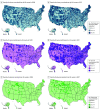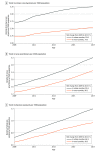Assessment of Changes in Rural and Urban Primary Care Workforce in the United States From 2009 to 2017
- PMID: 33112401
- PMCID: PMC7593812
- DOI: 10.1001/jamanetworkopen.2020.22914
Assessment of Changes in Rural and Urban Primary Care Workforce in the United States From 2009 to 2017
Abstract
Importance: Access to primary care clinicians, including primary care physicians and nonphysician clinicians (nurse practitioners and physician assistants) is necessary to improving population health. However, rural-urban trends in primary care access in the US are not well studied.
Objective: To assess the rural-urban trends in the primary care workforce from 2009 to 2017 across all counties in the US.
Design, setting, and participants: In this cross-sectional study of US counties, county rural-urban status was defined according to the national rural-urban classification scheme for counties used by the National Center for Health Statistics at the Centers for Disease Control and Prevention. Trends in the county-level distribution of primary care clinicians from 2009 to 2017 were examined. Data were analyzed from November 12, 2019, to February 10, 2020.
Main outcomes and measures: Density of primary care clinicians measured as the number of primary care physicians, nurse practitioners, and physician assistants per 3500 population in each county. The average annual percentage change (APC) of the means of the density of primary care clinicians over time was calculated, and generalized estimating equations were used to adjust for county-level sociodemographic variables obtained from the American Community Survey.
Results: The study included data from 3143 US counties (1167 [37%] urban and 1976 [63%] rural). The number of primary care clinicians per 3500 people increased significantly in rural counties (2009 median density: 2.04; interquartile range [IQR], 1.43-2.76; and 2017 median density: 2.29; IQR, 1.57-3.23; P < .001) and urban counties (2009 median density: 2.26; IQR. 1.52-3.23; and 2017 median density: 2.66; IQR, 1.72-4.02; P < .001). The APC of the mean density of primary care physicians in rural counties was 1.70% (95% CI, 0.84%-2.57%), nurse practitioners was 8.37% (95% CI, 7.11%-9.63%), and physician assistants was 5.14% (95% CI, 3.91%-6.37%); the APC of the mean density of primary care physicians in urban counties was 2.40% (95% CI, 1.19%-3.61%), nurse practitioners was 8.64% (95% CI, 7.72%-9.55%), and physician assistants was 6.42% (95% CI, 5.34%-7.50%). Results from the generalized estimating equations model showed that the density of primary care clinicians in urban counties increased faster than in rural counties (β = 0.04; 95% CI, 0.03 to 0.05; P < .001).
Conclusions and relevance: Although the density of primary care clinicians increased in both rural and urban counties during the 2009-2017 period, the increase was more pronounced in urban than in rural counties. Closing rural-urban gaps in access to primary care clinicians may require increasingly intensive efforts targeting rural areas.
Conflict of interest statement
Figures


Similar articles
-
Potentially Excess Deaths from the Five Leading Causes of Death in Metropolitan and Nonmetropolitan Counties - United States, 2010-2017.MMWR Surveill Summ. 2019 Nov 8;68(10):1-11. doi: 10.15585/mmwr.ss6810a1. MMWR Surveill Summ. 2019. PMID: 31697657
-
National Health Service Corps staffing and the growth of the local rural non-NHSC primary care physician workforce.J Rural Health. 2006 Fall;22(4):285-93. doi: 10.1111/j.1748-0361.2006.00048.x. J Rural Health. 2006. PMID: 17010024
-
Assessment of Rural-Urban Differences in Postacute Care Utilization and Outcomes Among Older US Adults.JAMA Netw Open. 2020 Jan 3;3(1):e1918738. doi: 10.1001/jamanetworkopen.2019.18738. JAMA Netw Open. 2020. PMID: 31913495 Free PMC article.
-
Urban-Rural Disparities in Pulmonary Hypertension-Related Mortality Between 2004 and 2019: A Call to Improve Access to Specialty Care Centers for Rural Residents in the United States.Curr Probl Cardiol. 2023 Jun;48(6):101623. doi: 10.1016/j.cpcardiol.2023.101623. Epub 2023 Jan 31. Curr Probl Cardiol. 2023. PMID: 36731687 Review.
-
Insurance and Access to Care in Urban and Rural Areas, 2014-2015.2018 May. In: Statistical Brief (Medical Expenditure Panel Survey (US)) [Internet]. Rockville (MD): Agency for Healthcare Research and Quality (US); 2001–. STATISTICAL BRIEF #512. 2018 May. In: Statistical Brief (Medical Expenditure Panel Survey (US)) [Internet]. Rockville (MD): Agency for Healthcare Research and Quality (US); 2001–. STATISTICAL BRIEF #512. PMID: 29792620 Free Books & Documents. Review.
Cited by
-
Rural Internal Medicine Residencies: Models, Facilitators, Barriers, and Equity Considerations.J Gen Intern Med. 2023 Aug;38(11):2607-2612. doi: 10.1007/s11606-023-08044-3. Epub 2023 Feb 2. J Gen Intern Med. 2023. PMID: 36732437 Free PMC article.
-
Perceived Well-Being among Adults with Diabetes and Hypertension: A National Study.Healthcare (Basel). 2024 Apr 16;12(8):844. doi: 10.3390/healthcare12080844. Healthcare (Basel). 2024. PMID: 38667606 Free PMC article.
-
Inequality in households' access to primary health care (PHC): a case study in Kerman, southeast Iran.BMC Health Serv Res. 2022 Aug 23;22(1):1077. doi: 10.1186/s12913-022-08467-4. BMC Health Serv Res. 2022. PMID: 35999541 Free PMC article.
-
Access improvement in healthcare: a 12-step framework for operational practice.Front Health Serv. 2025 Jan 3;4:1487914. doi: 10.3389/frhs.2024.1487914. eCollection 2024. Front Health Serv. 2025. PMID: 39831147 Free PMC article.
-
Community food insecurity predicts child maltreatment report rates across Illinois zip codes, 2011-2018.Ann Epidemiol. 2022 Sep;73:30-37. doi: 10.1016/j.annepidem.2022.06.002. Epub 2022 Jun 17. Ann Epidemiol. 2022. PMID: 35718099 Free PMC article.
References
-
- Meit M, Knudson A, Gilbert T The 2014. update of the rural-urban chartbook. Accessed September 30, 2020. https://ruralhealth.und.edu/projects/health-reform-policy-research-cente...
Publication types
MeSH terms
Grants and funding
LinkOut - more resources
Full Text Sources
Medical

